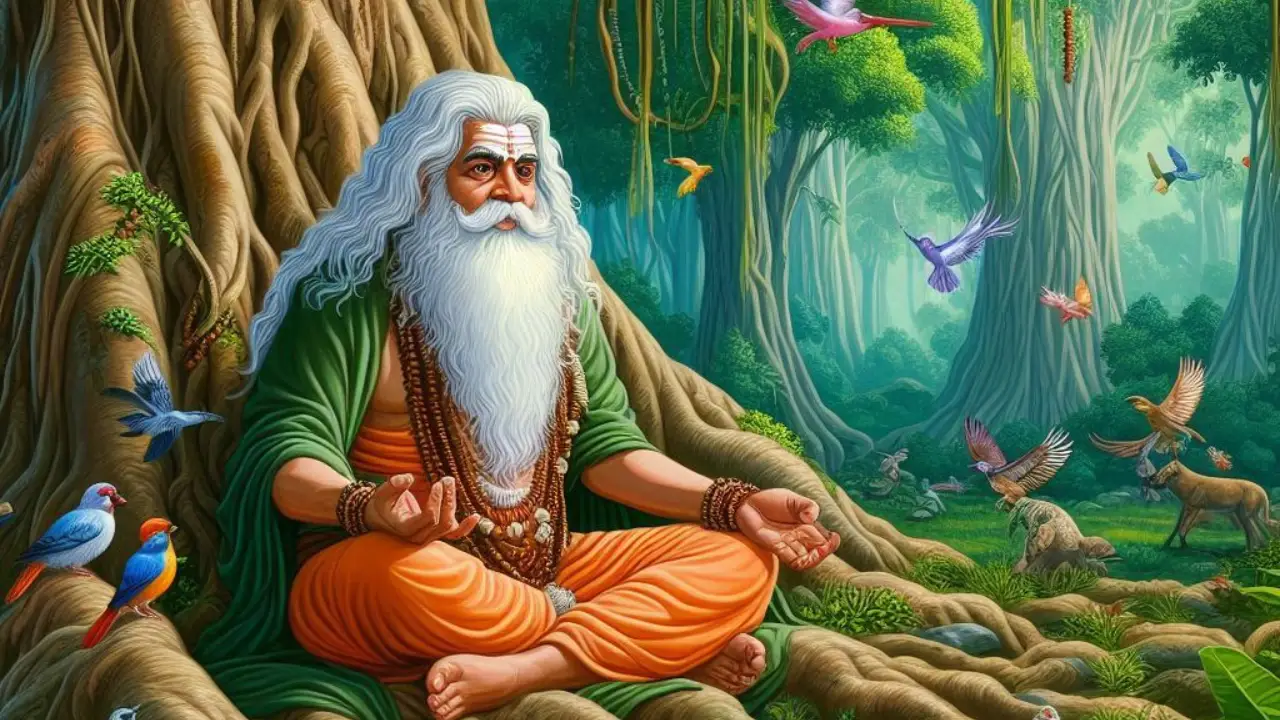Throughout Hindu mythology, few figures are as revered or integral as Sage Kashyapa. Known as the “father of all creatures,” Kashyapa’s story is one of wisdom, devotion, and profound responsibility. His life marks his role in creating numerous life forms, marrying diverse daughters of Daksha, and holding a vital place in the stories that shape Hindu belief. Understanding his contributions allows us to glimpse the ancient wisdom and universal principles that remain relevant even today.
Who Was Sage Kashyapa?
Sage Kashyapa, often referred to as Prajapati Kashyapa, holds a place of honor in Hindu texts. As one of the original creators, he is considered a mind-born son (or “Manasaputra”) of Brahma, the Creator. Kashyapa’s name is derived from “kash,” which means “to shine.” This title points to his illuminating wisdom and contributions to Hindu lore.
His deep knowledge, powerful spirituality, and devotion made him instrumental in propagating life across the earth. It was through his relationships with various daughters of Daksha, another significant figure, that Kashyapa became known as the progenitor of the multitude of life forms.
Kashyapa’s Marriages: The Roots of Creation
In many Puranic tales, we find Sage Kashyapa married to multiple daughters of Daksha. Each wife had a role in creating distinct life forms, representing different aspects of existence. Notable wives of Kashyapa include Aditi, Diti, Kadru, Vinata, and Danu. They contributed to life’s diversity through their offspring.
Aditi: Aditi is often called the mother of the Devas, or celestial beings. She gave birth to the Adityas, who represent the twelve aspects of the sun. These aspects symbolize various qualities of light and consciousness. Vamana, Aditi’s eldest son, is one of Vishnu’s ten avatars. This highlights Aditi’s role in preserving cosmic balance.
Diti: The progeny of Diti is equally significant, as she gave birth to the Asuras, beings who were often at odds with the Devas. The Asuras, often seen as antagonistic forces, represent essential cosmic principles and offer a counterbalance to the Devas. This dynamic represents the dual forces of good and evil, which continuously interact within the universe.
Kadru: Through Kadru, Kashyapa fathered the Nagas, or serpent deities. The Nagas are powerful, sometimes wrathful beings, but they also symbolize transformation, wisdom, and the cyclical nature of life and death. They hold a respected place in Hinduism and continue to be worshipped in regions throughout India.
Vinata: Vinata bore Garuda, the mighty eagle and the vehicle of Lord Vishnu. Garuda embodies the qualities of devotion, speed, and strength. He is also the sworn enemy of the Nagas, representing the complex relationships between different forms of life created by Kashyapa.
Danu: From Danu came the Danavas, a group of powerful beings with mystical knowledge. Their stories reflect the importance of balance between power and humility, as they often grappled with their role in the cosmic scheme.
Kashyapa’s Role in Hindu Cosmology
Sage Kashyapa’s legacy as the father of diverse life forms reflects the deep interconnectedness within Hindu cosmology. The relationships between Devas, Asuras, Nagas, and Garuda serve as metaphors for the balancing forces that govern existence. Kashyapa’s story offers insight into Hinduism’s view of the universe as a symphony of interrelated forces. Each force is essential to maintaining the world’s equilibrium.
His role as a creator goes beyond generating beings. Kashyapa embodies the ideal sage, balancing duty, devotion, and wisdom. In many stories, he is a wise, impartial figure. He counsels both Devas and Asuras, transcending their differences.
Lessons from Kashyapa’s Legacy
Unity in Diversity: Kashyapa’s story emphasizes that diversity is part of a greater unity. The Devas, Asuras, Nagas, and other beings have distinct characteristics but ultimately coexist as manifestations of divine will.
Acceptance of Differences: Through his various wives and offspring, Kashyapa’s life shows that all beings, whether revered or feared, have a purpose. This principle encourages us to recognize the value in diversity, understanding that differences can coexist in harmony.
Respect for the Balance of Nature: Kashyapa’s story is also a reminder of the delicate balance needed to maintain life. The interplay between different forces, represented by his children, speaks to the importance of maintaining ecological and spiritual balance.
Endurance and Wisdom: Sage Kashyapa’s enduring influence across different ages of Hindu mythology is a testament to his profound wisdom. His balanced approach to life’s challenges, rooted in knowledge and patience, serves as an example for all.
The Modern Relevance of Kashyapa’s Teachings
In today’s world, the ancient wisdom embodied by Kashyapa’s story remains relevant. The emphasis on balance, unity, and respect for diversity resonates with modern concerns about ecological conservation, coexistence, and acceptance of differences.
By understanding and embracing these principles, we can strive for harmony within our own lives and communities. Kashyapa’s teachings can serve as a foundation for fostering respect and compassion toward all beings, recognizing that each form of life has a purpose and place in the grand scheme of things.
Why Kashyapa is Revered in Hinduism
Sage Kashyapa holds a unique place in the hearts of many for his role as the father of all creatures. His life serves as a sacred reminder that creation is a divine process requiring responsibility, patience, and devotion. By embracing the values he embodied, we honor not only Kashyapa but also the universal principles of life, balance, and respect.
Conclusion
The story of Sage Kashyapa is more than myth; it teaches coexistence, balance, and respect for life. From the creation of the Devas to the mighty Garuda, Kashyapa’s legacy shows us how to embrace diversity. His wisdom guides us to find harmony among opposing forces. Let’s apply these principles in our own lives.

